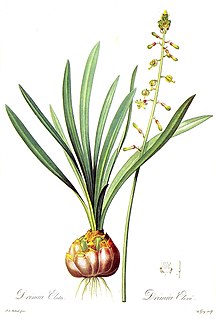
Drosera capensis, commonly known as the Cape sundew, is a small rosette-forming carnivorous species of perennial sundew native to the Cape in South Africa. Because of its size, easy to grow nature, and the copious amounts of seed it produces, it has become one of the most common sundews in cultivation, and thus, one of the most frequently introduced and naturalised invasive Drosera species.

Nymphaea nouchali var. caerulea, also known as Nymphaea caerulea, and known in English as Egyptian lotus, blue lotus, blue water lily (RSA), Cape water lily (RSA), frog's pulpit (RSA), blue lotus of the Nile, blue waterlily, blue Egyptian lotus, blue Egyptian water lily (India), sacred blue lily of the Nile (India), Utpala (India), Cape blue waterlily (USA) and sacred blue lily, is a water lily in the genus Nymphaea, a botanical variety of Nymphaea nouchali.

Nymphaea capensis is an aquatic flowering plant of the water lily family Nymphaeaceae.

Phygelius capensis, the cape figwort or cape fuchsia, is a species of flowering plant in the family Scrophulariaceae, native to South Africa.

Tecoma capensis, the Cape honeysuckle, is a species of flowering plant in the family Bignoniaceae, native to southern Africa. Despite its common name, it is not closely related to the true honeysuckle.

Drimia maritima is a species of flowering plant in the family Asparagaceae, subfamily Scilloideae. This species is known by several common names, including squill, sea squill, sea onion, and maritime squill. It may also be called red squill, particularly a form which produces red-tinged flowers instead of white. It is native to southern Europe, western Asia, and northern Africa.

Felicia amelloides, the blue daisy bush or blue felicia, is a hairy, soft, usually perennial, evergreen plant, in the family Asteraceae. It can be found along the southern coast of South Africa. It grows as ground cover and produces many very regular branches. It mostly grows to about 50 cm (1.6 ft) high, rarely to 1 m. The leaves are oppositely arranged along the stems, dark green in colour and elliptic in shape. The flower heads sit individually on up to 18 cm (7 in) long, green to dark reddish stalks. They consist of about twelve heavenly blue ray florets that surround many yellow disc florets, together measuring about 3 cm across. It is also cultivated as an ornamental, and was introduced in Europe in the middle of the 18th century.

Crassothonna capensis, also known as little pickles (USA), ruby necklace (Australia), Cape aster, Cape Othonna, and Bobbejaankool (Afrikaans), is a species of the genus Crassothonna previously (Othonna) in the family Asteraceae, and is a native of the Eastern Cape of South Africa. It is a native highveld species that originates from the southern Drakensberg region.

Ekebergia capensis is a tree in the family Meliaceae. It is commonly known as the Cape ash. Its range extends from the Eastern Cape of South Africa to Sudan and Ethiopia.

Knowltonia vesicatoria (Brandblaar) is an attractive, shade-loving plant of the family Ranunculaceae, that is indigenous to the southern parts of South Africa.

Drimia is a genus of flowering plants. In the APG IV classification system, it is placed in the family Asparagaceae, subfamily Scilloideae. When broadly circumscribed, the genus includes a number of other genera previously treated separately, including Litanthus, Rhodocodon, Schizobasis and Urginea.

Babiana nana is a species of geophyte of 6–15 cm (2.4–5.9 in) high that is assigned to the family Iridaceae. It has leaves that consist of a sheath and a blade that are at an angle with each other. The leaf blades are oval to almost line-shaped and have a left and right surface, rather than an upper and lower surface. The leaf blades are moderately pleated and covered in dense, soft hairs. The inflorescence contains two to six blue to violet or pale pink flowers adorned with white markings on the lower lip, and with three stamens crowding under the upper lip. Flowering occurs from late August to the end of September. The flowers emit a smell reminiscent of roses or violets.

Veltheimia capensis is one of two species of flowering plants belonging to the genus Veltheimia, of the family Asparagaceae. It is a tender bulbous perennial reaching a height of 46 cm (18 in), with flowers varying in color from white with red spots to pink with green or red markings.
Drimia indica is a species of flowering plant found from South Asia to South Africa.

Drimia elata is a species of flowering plant in the family Asparagaceae, subfamily Scilloideae. It is widely distributed in eastern and southern Africa.

Wahlenbergia capensis, commonly known as the Cape bluebell, is a plant in the family Campanulaceae and is native to the Cape Province but has been introduced to Australia. It is an annual herb with up to four greenish blue, bell-shaped flowers with spreading petal lobes.

Bulbine alooides ("Rooistorm") is a species of geophytic plant in the genus Bulbine. It is widespread in rocky areas in the southern Cape of South Africa.

Drimia exuviata ("Gifbol") is a species of flowering plant in the family Asparagaceae, subfamily Scilloideae, indigenous to the south-western parts of South Africa.
Asparagus burchellii, is a shrub of the Asparagus genus, that is indigenous to dry scrub vegetion in the southern Cape region, South Africa.

Anisodontea capensis, known as African mallow, dwarf hibiscus, Cape mallow and false mallow, is a species in the tribe Malveae in the family Malvaceae that is native to South Africa. It has gained the Royal Horticultural Society's Award of Garden Merit as an ornamental.


















